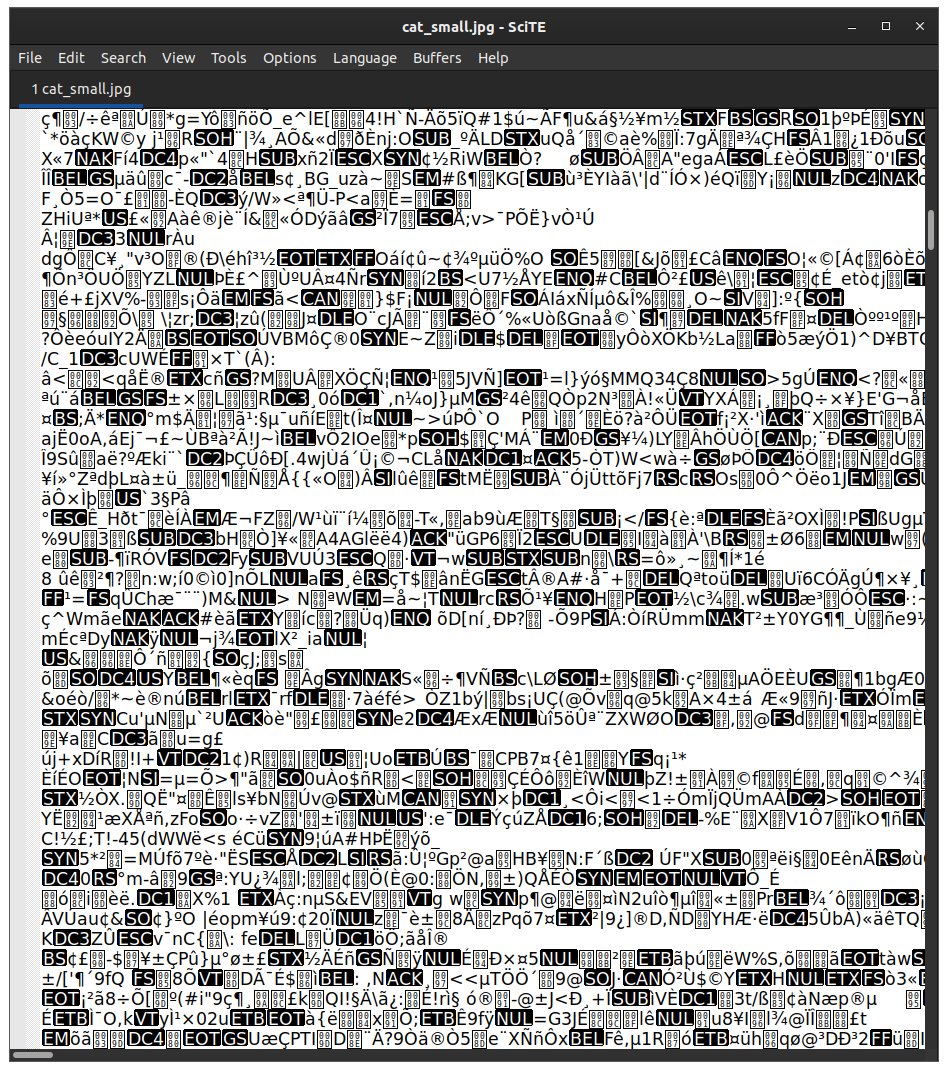Around the same time as doing fizzPOP I also came across glitch art. If you've ever seen a broken screen, had the tv picture distort then you've probably accidentally made glitch art! Glitch artists misuse software and cause errors in systems to make art.
A common method is to open a jpg in a text editor (Scite, TextEdit or Notepad will do) and modify the text. When you open the jpg this way you'll see a lot of random characters. Jpgs aren't meant to be edited in this textual way and so it produces very unexpected results.
Here's an example I made using a picture of a cat. Give it a try and share what you've made! I'll retweet the best ones
I was really excited at learning this. it had the right mixture of technology, creative exploration and randomness to keep me wanting more! Another method which I documented in 2009 instead uses an audio editor (Audacity) to edit the image. This process is called databending.
Using a few tricks you can import an image into the Audacity software and listen to it. Here's what that cat image sounds like. Warning, it's noisy!
In Audacity I'm now gonna apply the wahwah effect. When we export it back out you can see how the changing audio frequencies affect the image.
This unconventional way editing images is possible because everything on a computer is data. When you open a file you're telling the computer to interpret the data in a certain way and display the image/play the audio. But we can trick software into interpreting data in any way
The process for editing images in this way is a bit more complex so I wrote a tutorial that should guide you through it https://www.hellocatfood.com/databending-using-audacity/ You'll just need the Audacity audio editor
I've continued making art by "misusing" software but also using generative techniques. An example of this is the 2014 artwork Glass which @TateCollective @Tate commissioned. It is a generative artwork, meaning that once it starts it will never loop!
It was made using software called Pure Data, which is a visual programming language used primarily for (generative) music and visuals. Rather than typing lines of code, you link functions through connecting lines. I find it a good way of visualising the flow of data.
In this particular code which made the video you can see functions like [metro] (metronome) and [random], which basically generates a random number every x milliseconds. With so many of these random number generators it's very unlikely that it'll ever repeat!
If you're interested in learning more about Pure Data I regularly write tutorials and talk about my processes e.g. https://www.hellocatfood.com/five-days-of-pure-data-image-to-signal/
Armed with these glitchy software and programming techniques over the last 10ish years I've been fortunate to make artworks which have appeared at Tate, Barbican, Jerwood Arts, V&A, and internationally in Chicago, Berlin, New York, Bergen, Toronto, and more!
I'm of course very thankful to have had these opportunities but throughout there was a thing that bugged me. In a lot of these cultural spaces I have often found myself being the only or one of a few people of colour.
Naively, early in my career I assumed that with digital art being a niche area that there wouldn't be many Black people doing it. As I've come to learn there is in fact a rich history and present of Black people working in computing, culture and with creative technology.
In tomorrow's posts I'll be talking about this and about those people and moments that have inspired me!

 Read on Twitter
Read on Twitter







![In this particular code which made the video you can see functions like [metro] (metronome) and [random], which basically generates a random number every x milliseconds. With so many of these random number generators it's very unlikely that it'll ever repeat! In this particular code which made the video you can see functions like [metro] (metronome) and [random], which basically generates a random number every x milliseconds. With so many of these random number generators it's very unlikely that it'll ever repeat!](https://pbs.twimg.com/media/EouWQrhUwAM_r8u.png)
![In this particular code which made the video you can see functions like [metro] (metronome) and [random], which basically generates a random number every x milliseconds. With so many of these random number generators it's very unlikely that it'll ever repeat! In this particular code which made the video you can see functions like [metro] (metronome) and [random], which basically generates a random number every x milliseconds. With so many of these random number generators it's very unlikely that it'll ever repeat!](https://pbs.twimg.com/media/EouWQrVU8AMpfRM.png)
![In this particular code which made the video you can see functions like [metro] (metronome) and [random], which basically generates a random number every x milliseconds. With so many of these random number generators it's very unlikely that it'll ever repeat! In this particular code which made the video you can see functions like [metro] (metronome) and [random], which basically generates a random number every x milliseconds. With so many of these random number generators it's very unlikely that it'll ever repeat!](https://pbs.twimg.com/media/EouWQsIUwAELkoW.png)
![In this particular code which made the video you can see functions like [metro] (metronome) and [random], which basically generates a random number every x milliseconds. With so many of these random number generators it's very unlikely that it'll ever repeat! In this particular code which made the video you can see functions like [metro] (metronome) and [random], which basically generates a random number every x milliseconds. With so many of these random number generators it's very unlikely that it'll ever repeat!](https://pbs.twimg.com/media/EouWQrZUYAE8VV8.png)






